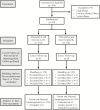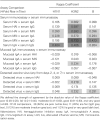Immunogenicity and Viral Shedding of Russian-Backbone, Seasonal, Trivalent, Live, Attenuated Influenza Vaccine in a Phase II, Randomized, Placebo-Controlled Trial Among Preschool-Aged Children in Urban Bangladesh
- PMID: 30481272
- PMCID: PMC6695509
- DOI: 10.1093/cid/ciy1003
Immunogenicity and Viral Shedding of Russian-Backbone, Seasonal, Trivalent, Live, Attenuated Influenza Vaccine in a Phase II, Randomized, Placebo-Controlled Trial Among Preschool-Aged Children in Urban Bangladesh
Abstract
Background: We evaluated a Russian-backbone, live, attenuated influenza vaccine (LAIV) for immunogenicity and viral shedding in a randomized, placebo-controlled trial among Bangladeshi children.
Methods: Healthy children received a single, intranasal dose of LAIV containing the 2011-2012 recommended formulation or placebo. Nasopharyngeal wash (NPW) specimens were collected on days 0, 2, 4, and 7. Reverse transcription polymerase chain reactions and sequencing identified the influenza virus (vaccine or wild-type). On days 0 and 21, blood specimens were collected to assess immunogenicity using hemagglutination inhibition, microneutralization, and immunoglobulin A (IgA) and G enzyme-linked immunosorbent assays (ELISAs); NPW specimens were also collected to assess mucosal immunogenicity using kinetic IgA ELISA.
Results: We enrolled 300 children aged 24 through 59 months in the immunogenicity and viral shedding analyses. Among children receiving LAIV, 45% and 67% shed A/H3N2 and B vaccine strains, respectively. No child shed A/H1N1 vaccine strain. There were significantly higher day 21 geometric mean titers (GMTs) for the LAIV, as compared to the placebo groups, in all immunoassays for A/H3N2 and B (log10 titer P < .0001; GMT Ratio >2.0). Among immunoassays for A/H1N1, only the mucosal IgA GMT was significantly higher than placebo at day 21 (log10 titer P = .0465).
Conclusions: Children vaccinated with LAIV had serum and mucosal antibody responses to A/H3N2 and B, but only a mucosal IgA response to A/H1N1. Many children shed A/H3N2 and B vaccine strains, but none shed A/H1N1. More research is needed to determine the reason for decreased LAIV A/H1N1 immunogenicity and virus shedding.
Clinical trials registration: NCT01625689.
Keywords: Bangladesh; children; clinical trials; influenza vaccine.
© The Author(s) 2018. Published by Oxford University Press for the Infectious Diseases Society of America.
Figures



Comment in
-
The Potential of Live, Attenuated Influenza Vaccine for the Prevention of Influenza in Children.Clin Infect Dis. 2019 Aug 16;69(5):795-796. doi: 10.1093/cid/ciy1007. Clin Infect Dis. 2019. PMID: 30517601 No abstract available.
References
-
- Neuzil KM, Bresee JS, de la Hoz F, et al. Data and product needs for influenza immunization programs in low- and middle-income countries: Rationale and main conclusions of the WHO preferred product characteristics for next-generation influenza vaccines. Vaccine 2017; 35: 5734–7. - PubMed
-
- World Health Organization. Preferred product characteristics for next-generation influenza vaccines Available at: http://apps.who.int/iris/bitstream/10665/258767/1/9789241512466-eng.pdf Accessed 13 September 2017.
-
- Belshe RB, Edwards KM, Vesikari T, et al. ; CAIV-T Comparative Efficacy Study Group. Live attenuated versus inactivated influenza vaccine in infants and young children. N Engl J Med 2007; 356:685–96. - PubMed
-
- Belshe RB, Ambrose CS, Yi T. Safety and efficacy of live attenuated influenza vaccine in children 2-7 years of age. Vaccine 2008; 26(Suppl 4):D10–6. - PubMed
Publication types
MeSH terms
Substances
Associated data
LinkOut - more resources
Full Text Sources
Medical
Miscellaneous

